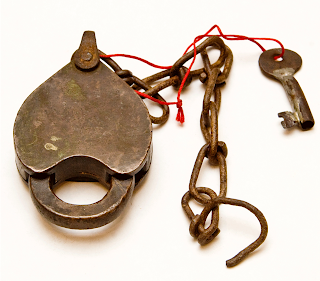Locks, love, and wishes
A heart-shaped lock in our Cantonese Family Locks exhibit brings to mind a modern Chinese phenomenon that has spread around the world, meeting with much fascination, and some disdain.
Atop numerous mountains and at other scenic locations, it is common to see padlocks engraved with lovers’ names. People commonly attach these locks to safety railings on China’s famous mountains, and then they cast the keys into the valleys as a symbol of their undying love.
Some say, that each over is supposed to hold onto a key to the lock (which would at least cut down on the litter). If one desires a divorce, he or she must climb back to the peak, unlock the lock, and return it to his or her former beloved to request a divorce. If the person’s desire to end the affair is justified, he or she will easily recover the lock among the thousands littering the mountain. However, if his or her motives are impure, the god of the mountain will cause them to fall to their death.
Atop numerous mountains and at other scenic locations, it is common to see padlocks engraved with lovers’ names. People commonly attach these locks to safety railings on China’s famous mountains, and then they cast the keys into the valleys as a symbol of their undying love.
Some say, that each over is supposed to hold onto a key to the lock (which would at least cut down on the litter). If one desires a divorce, he or she must climb back to the peak, unlock the lock, and return it to his or her former beloved to request a divorce. If the person’s desire to end the affair is justified, he or she will easily recover the lock among the thousands littering the mountain. However, if his or her motives are impure, the god of the mountain will cause them to fall to their death.
Another
story, set in the beautiful Huangshan Mountain 黄山, tells of a boy and a girl
who were deeply in love, but the girl’s father disapproved and would not permit
them to marry. The couple ran away to Huangshan, climbed the mountain, and
locked two locks together at its summit. Then, as those familiar with Chinese
love stories may have guessed, they both jumped to their death.
Even if this custom has its
origins in a hokey romance, it has captured imaginations all over the world.
The government of Lovelock, Nevada recently installed chains near its city hall
and renamed it Lover’s Lock Plaza in an attempt to draw tourism to the town
whose other claims to fame are possessing one of only two round courthouses in
the country and hosting O.J. Simpson at Lovelock Correctional Center. This is
also a somewhat unorthodox way of honoring the history of Chinese immigration
to the railroad town.
However, government officials are
not always so keyed up about the practice. In Rome, young people almost caused
a lamppost on the Milvian Bridge to collapse when they began locking their love
to it and throwing the keys into the Tiber River to imitate a scene in the
popular film, Tre Metri Sopra Il Cielo (Three Meters Above the Sky).
With a few more attractions than Lovelock, the Roman government felt that they
could ban this love-laden vandalism without detracting from tourism. However,
sweethearts found a new place to prove their affections on a church railing by
the famous Trevi Fountain, which became a receptacle for their keys. Not in
love with the idea, the parish priest had them removed.
Young people in Taiwan have put a
new spin on this tradition. They have begun locking padlocks inscribed with
wishes to a chain link fence on a railway overpass in Fengyuan 豐原, Taichung County. Supposedly, the train passing
under the walkway generates a magnetic field that infuses the locks with energy
to fulfill wishes for success on exams, money and, of course, love. Authorities
have removed the locks, but they keep reappearing. Perhaps they need to attach
a lock of their own, wishing for no more locks, as it seems that all other
attempts to eradicate them inevitably fail.
The locks in our exhibit
represent a variety of wishes, heart-shaped locks for love, cranes for long life,
slogans for success, and fish for prosperity and protection. Whether these
wishes could be granted by mountain gods, electromagnetism, or a complicated
splitting spring mechanism, or if curmudgeonly officials can foil them with
bolt cutters is anyone’s guess. All that we wish for here at the museum, is for
you to come see them before it’s too late.



Comments
Post a Comment